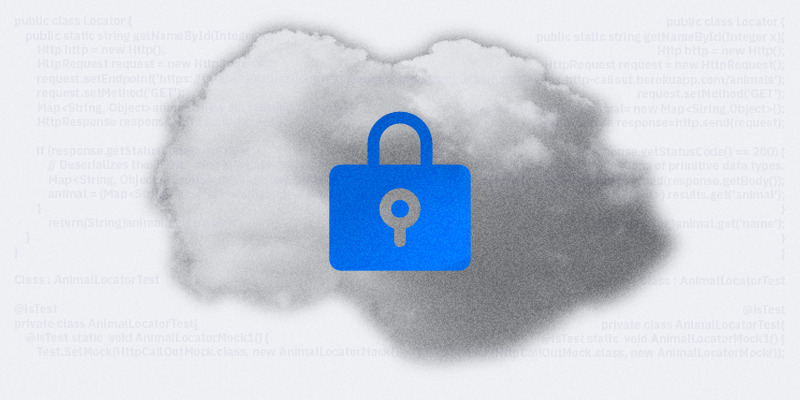
Salesforce Data Migration Best Practices: Protection
Strict adherence to best practices, utilization of proper tooling, and consistent processes protect your Salesforce data migration from accidental corruptions and potentially dangerous exposures.

Why It Matters: Improper data migrations lead to corrupted files, compromised data, and lost time. These processes are extremely beneficial if quality and security are kept in mind throughout the migration.
- Compliance standards must be addressed both in handling your data and the setup of your target environment.
- Transferring data comes with an inherent risk of corrupting or exposing sensitive information.
- Unsecured pathways between source and target environments are data security vulnerabilities.
Here are 9 considerations to keep in mind to protect your next Salesforce data migration:
- Use a Single Source of Truth
- Avoid Overexposing Data
- Mask Sensitive Information
- Fortify Access Points
- Utilize Automation
- Consider the Metadata
- Test It in a Sandbox
- Back Up Everything Beforehand
- Take Your Time
1. Use a Single Source of Truth
A successful Salesforce data migration requires consistency. Discrepancies lead to broken relationships, which result in faulty functionality and threaten the stability of your data. The infrastructure required to support your migration starts with your source of data.
Verifying the validity of your source location and identifying a single set of data ensures your migration won’t run into problematic inaccuracies.
Sorting through your data prior to migration is critical to ensure everything is accurate. This may take some time—especially for a large migration—but it will save you massive headaches in the future should anything need to be rectified.
2. Avoid Overexposing Data

Human error is a leading cause of data loss. Accidental deletions are simple mistakes that can have massive impacts on your Salesforce environment. The best way to minimize the potential of this constant threat is to ensure that the only people who are able to access certain data sets are the ones who need it to perform their duties.
Analyze profiles and permission sets and remove access from team members who don’t need it.
This simple step supports the goal of keeping your data accurate and safe, which is essential to a successful Salesforce data migration. Introducing a corrupted file prior to migration has a snowball effect on connected pieces of data. Utilize a policy scanner to verify proper permissions settings.
3. Masking for Sensitive Data Migration
The potential for exposure increases anytime you move data from one place to another. Think of a package sitting on your kitchen table versus one in transit with a postal carrier—one is behind a locked door, while the other has numerous points of possible interception.
Encryption, pseudonymization, and anonymization are all great methods for masking sensitive data during the migration process.
Personally identifiable information, financial data, and medical information must be properly guarded when being moved from one environment to another. Regulatory compliance relies on the strict protection of this data. More than that, people who trust an organization with this information are relying on you to take the necessary precautions to protect their confidential data.
4. Fortify Access Points

Your Salesforce environment is always in danger of experiencing a cyberattack. That is why we are so insistent on maintaining best practices when it comes to security considerations and incorporating the most efficient, up-to-date security tools on the market. And one of the main areas that needs to be protected is your sign-in portal.
Strong passwords and multi-factor authentication protect the often-targeted login screens.
This reinforces the stability of your environment and ensures nothing is corrupted prior to or after a Salesforce data migration. A cybercriminal can wreak havoc on an environment after gaining access to a team member’s login information. Protecting your data migration starts with protecting your user accounts.
5. Utilize Automation
As with any aspect of a Salesforce DevSecOps pipeline, automation is a massive help in reducing errors, increasing speed, and maintaining proper security measures. And for data migration, a data loader can expedite the process while providing essential security functions.
Data masking, validation, and transfer of files can all be automated with the right data-loading tool.
Here are some more ways a data loader can protect your next data migration:
- Verifies data integrity between the source and the destination.
- Schedules processes and migrations as they are needed.
- Maintains data history and failure reports.
These functions increase the security and reliability of data migrations, helping adhere to compliance standards and properly protecting your system.
6. Consider the Metadata
Realize you’re moving more than just your system data—you’re also migrating metadata. This essential aspect of your Salesforce environment provides key descriptive properties of existing data sets, while organizing relationships between various pieces of information, such as related fields and causational relationships.
The failure to ensure metadata is properly preserved throughout the data migration process can result in misfires and unintended consequences.
Consider any active triggers in your source environment. It might be necessary to disable active triggers connected to migrated data to avoid inadvertently activating a process and causing unintended results.
7. Test It in a Sandbox

Problems occasionally pop up in Salesforce data migrations, and the likelihood of an issue increases as the amount of data being migrated grows. Knowing this beforehand allows you to take precautions that keep you from scrambling to fix issues as they arise in a large environment.
Take a sample of your migrated data and run it in a sandbox. This gives you the ability to perform tests and evaluate how well your migration is going.
How long will the migration take? Will there be many errors to address? The answers to these questions can be inferred from tests in a sandbox. Then you can adjust your migration strategy to address emerging issues.
8. Back Up Everything Beforehand
A current snapshot of your Salesforce data and metadata should always be maintained. However, it’s a good idea to backup your system data right before running a data migration to be sure you don’t lose any critical information, should something go wrong.
A recent data backup serves numerous purposes for your organization—including providing a safety net should anything go awry during a migration.
Use this as an opportunity to create a repeatable schedule for backups if you don’t already have one in place. Not only does compliance require specific data protection stipulations, but maintaining a backup is also a best practice, so you can quickly restore operations should an outage occur.
9. Take Your Time

The process of cleaning up your data, establishing the criteria for a migration, performing the migration, and testing the results take the efforts of multiple team members from various departments. There needs to be a thorough plan in place that outlines who’s in charge of various tasks, how long the whole process should take, and budgeting forecasts.
Don’t rush the planning stage. Reducing re-work and the potential for errors far outweighs the cost of going slowly and methodically in these crucial early stages.
Protecting your data migrations includes hardening your Salesforce environment, data, and metadata as a whole. The benefits of a successful migration are great, but so are the risks if proper precautions are not taken. Remember that protection starts with planning. Don’t ignore this fundamental step.
Next Step…
Automation is a robust aspect of an optimized DevSecOps pipeline. And now that we understand how it can help data migration, let’s look at other ways automation streamlines Salesforce development.
Check out the “Top 10 Benefits of Automated Release Management” on our blog.
FAQs
What is a Salesforce data migration?
Your Salesforce environment is made up of a variety of types of data sets. These data sets are combined with metadata that describes the data and dictates how your environment functions. Sometimes it can be necessary to move these sets of data and metadata to a new environment or platform. However, you don’t want to build a new platform from scratch because it’s incredibly time consuming and difficult. A Salesforce data migration is the process of transporting these sets of data and metadata from one platform to another. This can go in either direction—either out of Salesforce or into it. The benefits of this include retaining familiar functionality and saving time when populating a new environment.
Can Salesforce data migrations be hacked?
Yes. Improper migrations run the risk of losing essential data in the process. This becomes a serious issue when the data in question is sensitive and covered by data security regulations. Faulty transfers of metadata lead to costly misfires that negatively impact the functionality of the environment. And if your data migrations aren’t structured properly, they’ll lead to a data loss that will take a lot of time and money to get back. There are a variety of data security concerns for migrations, so the environments on both ends of the process must be protected to avoid unauthorized access by bad actors.
How can I be sure my Salesforce data migrated properly?
It’s important to take some time after a migration to verify everything came through without any errors. This can be done by checking the data relationships and file types in the new environment against corresponding data in the source environment. Check for corrupted files and improperly configured relationships that could have impacts on surrounding data sets. After comparing the original environment against the new one, rectify any discrepancies and pay close attention as you move forward for any unseen errors in functionality.

